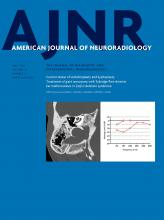Abstract
BACKGROUND AND PURPOSE: Cochlear malformations may be be subtle on imaging studies. The purpose of this study was to evaluate the angle and depth of the lateral second interscalar ridge or notch in ears without sensorineural hearing loss (normal ears) and compare them with ears that have a documented incomplete type II partition malformation.
MATERIALS AND METHODS: The second interscalar ridge notch angle and depth were measured on MR imaging in normal ears by a single experienced neuroradiologist. The images of normal and incomplete partition II malformation ears were then randomly mixed for 2 novice evaluators to measure both the second interscalar ridge notch angle and depth in a blinded manner. For the mixed group, interobserver agreement was calculated, normal and abnormal ear measurements were compared, and receiver operating characteristic curves were generated.
RESULTS: The 94 normal ears had a mean second interscalar ridge angle of 80.86° ± 11.4° and depth of 0.54 ± 0.14 mm with the 98th percentile for an angle of 101° and a depth of 0.3 mm. In the mixed group, agreement between the 2 readers was excellent, with significant differences for angle and depth found between normal and incomplete partition type II ears for angle and depth on average (P < .001). Receiver operating characteristic cutoffs for delineating normal from abnormal ears were similar for both readers (depth, 0.31/0.34 mm; angle, 114°/104°).
CONCLUSIONS: A measured angle of >114° and a depth of the second interscalar ridge notch of ≤0.31 mm suggest the diagnosis of incomplete partition type II malformation and scala communis. These measurements can be accurately made by novice readers.
ABBREVIATIONS:
- IP-II
- incomplete partition type II
- R2
- second interscalar ridge
- SNHL
- sensorineural hearing loss
- © 2018 by American Journal of Neuroradiology







